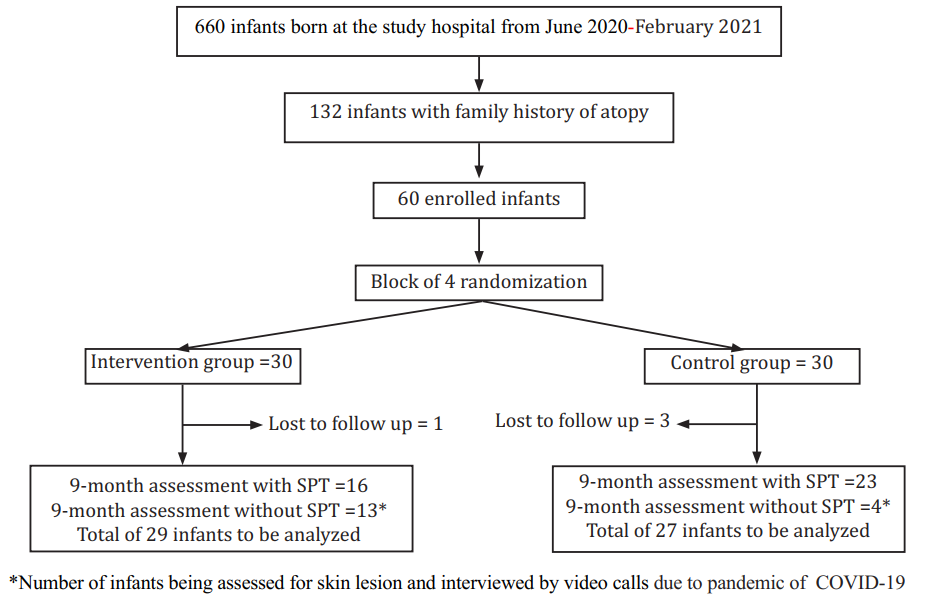EFFECTIVENESS OF ENHANCING THE SKIN BARRIER SINCE EARLY INFANCY TO PREVENT INFANTILE ATOPIC DERMATITIS AND FOOD SENSITIZATION: A RANDOMIZED CONTROLLED TRIAL
DOI:
https://doi.org/10.55374/jseamed.v8.170Keywords:
atopic dermatitis, emollient, food sensitization, skin prick testAbstract
Background: Atopic dermatitis (AD) mainly affects young children. The primary prevention of AD was investigated among high-risk infants. Objective: The study aimed to determine whether enhancing the skin barrier since early infancy would affect primary prevention and food sensitization.
Methods: A randomized controlled trial of 60 high-risk infants with a family history of atopy, aged up to 10 weeks, were enrolled. They were randomly assigned to either the intervention group receiving an inhouse emollient (cold cream) or the control group receiving only routine skin care education. The dermatologic assessment was recorded at ages 2, 4, 6, 8, 9 and 12 months. The skin prick test (SPT) with the top eight food allergens was performed at nine months.
Results: Fifty-six infants contributed to the study. A total of 11 (19.6%) developed AD, comprising 7 (24.1%) in the intervention group and 4 (14.8%) in the control group, with p = 0.380. Only 39 infants undergoing SPT with food sensitization found among 6 (15.4%) infants were comparable between the two groups (p = 0.674).
Conclusion: We could not conclude that enhancing the skin barrier among high-risk infants could prevent AD and food sensitization.
Downloads
Metrics
References
Hanifin, Rajka G. Diagnostic features of atopic dermatitis. Acta Derm Venereol 1980; 92: 44-7. DOI: https://doi.org/10.2340/00015555924447
Eichenfield LF, Tom WL, Chamlin SL, Feldman SR, Hanifin JM, Simpson EL, et al. Guidelines of care for the management of atopic dermatitis: Section 1. Diagnosis and assessment of atopic dermatitis Work Group. J Am Acad Dermatol 2014; 70: 338-51. DOI: https://doi.org/10.1016/j.jaad.2013.10.010
Odhiambo JA, Williams HC, Clayton TO, Robertson CF, Asher MI, Aït-Khaled N, et al. Global variations in prevalence of eczema symptoms in children from ISAAC Phase Three. J Allergy Clin Immunol 2009; 124: 1251-8. DOI: https://doi.org/10.1016/j.jaci.2009.10.009
Barbarot S, Auziere S, Gadkari A, Girolomoni G, Puig L, Simpson EL, et al. Epidemiology of atopic dermatitis in adults: Results from an international survey. Allergy: Eur J Allergy Clin Immunol 2018; 73: 1284-93. DOI: https://doi.org/10.1111/all.13401
Carlsten C, Dimich-Ward H, Ferguson A, Watson W, Rousseau R, Dybuncio A, et al. Atopic dermatitis in a high-risk cohort: Natural history, associated allergic outcomes, and risk factors. Ann Allergy Asthma Immunol 2013; 110: 24-8. DOI: https://doi.org/10.1016/j.anai.2012.10.005
Birdi G, Cooke R, Knibb RC. Impact of atopic dermatitis on quality of life in adults: a systematic review and meta-analysis. Int J Dermatol 2020; 59: e75-91. DOI: https://doi.org/10.1111/ijd.14763
Begolka WS, Chovatiya R, Thibau IJ, Silverberg JI. Financial Burden of Atopic Dermatitis Out-of-Pocket Health Care Expenses in the United States. Dermatitis 2021; 32: S62-70. DOI: https://doi.org/10.1097/DER.0000000000000715
Kim BE, Leung DY. Epidermal barrier in atopic dermatitis. Allergy Asthma Immunol Res 2012; 4: 12-6. DOI: https://doi.org/10.4168/aair.2012.4.1.12
Sandilands A, O’Regan GM, Liao H, Zhao Y, Terron-Kwiatkowski A, Watson RM, et al. Prevalent and rare mutations in the gene encoding filaggrin cause ichthyosis vulgaris and predispose individuals to atopic dermatitis. J Invest Dermatol 2006; 126: 1770-5. DOI: https://doi.org/10.1038/sj.jid.5700459
Foisy M, Boyle RJ, Chalmers JR, Simpson EL, Williams HC. The prevention of eczema in infants and children: an overview of Cochrane and non-Cochrane reviews. Evid Based Child Health 2011; 6: 1322-39. DOI: https://doi.org/10.1002/ebch.827
Simpson EL, Chalmers JR, Hanifin JM, Thomas KS, Cork MJ, McLean WHI, et al. Emollient enhancement of the skin barrier from birth offers effective atopic dermatitis prevention. J Allergy Clin Immunol 2014; 134: 818-23. DOI: https://doi.org/10.1016/j.jaci.2014.08.005
Horimukai K, Morita K, Narita M, Kondo M, Kitazawa H, Nozaki M, et al. Application of moisturizer to neonates prevents development of atopic dermatitis. J Allergy Clin Immunol 2014; 134: 824-30. DOI: https://doi.org/10.1016/j.jaci.2014.07.060
Thitthiwong P, Koopitakkajorn T. The good skin care practices and emollient use since early infancy as the primary prevention of infantile atopic dermatitis among infants at risk: A randomized controlled trial. Siriraj Med J 2020; 72: 41-6. DOI: https://doi.org/10.33192/Smj.2020.06
Chalmers JR, Haines RH, Bradshaw LE, Montgomery AA, Thomas KS, Brown SJ, et al. Daily emollient during infancy for prevention of eczema: the BEEP randomised controlled trial. Lancet 2020; 395: 962-72. DOI: https://doi.org/10.1016/S0140-6736(19)32984-8
Lack G, Fox D, Northstone K, Golding J. Factors Associated with the Development of Peanut Allergy in Childhood. N Engl J Med 2003348: 977-85. DOI: https://doi.org/10.1056/NEJMoa013536
Samady W, Warren C, Kohli S, Jain R, Bilaver L, Mancini AJ, et al. The prevalence of atopic dermatitis in children with food allergy. Ann Allergy Asthma Immunol 2019; 122: 656-7. DOI: https://doi.org/10.1016/j.anai.2019.03.019
Lowe AJ, Su JC, Allen KJ, Abramson MJ, Cranswick N, Robertson CF, et al. A randomized trial of a barrier lipid replacement strategy for the prevention of atopic dermatitis and allergic sensitization: the PEBBLES pilot study. Br J Dermatol 2018; 178: e19-21. DOI: https://doi.org/10.1111/bjd.15747
Tham EH, Rajakulendran M, Lee BW, van Bever HPS. Epicutaneous sensitization to food allergens in atopic dermatitis: What do we know?. Pediatr Allergy Immunol 2020; 31: 7-18. DOI: https://doi.org/10.1111/pai.13127
Skjerven HO, Rehbinder EM, Vettukattil R, LeBlanc M, Granum B, Haugen G, et al. Skin emollient and early complementary feeding to prevent infant atopic dermatitis (PreventADALL): a factorial, multicentre, cluster-randomised trial. Lancet 2020; 395: 951-61. DOI: https://doi.org/10.1016/S0140-6736(19)32983-6
Kelleher MM, Cro S, van Vogt E, Cornelius V, Lodrup Carlsen KC, Ove Skjerven H, et al. Skincare interventions in infants for preventing eczema and food allergy: A cochrane systematic review and individual participant data meta-analysis. Clin Exp Allergy 2021; 51: 402-18. DOI: https://doi.org/10.1111/cea.13847

Downloads
Published
How to Cite
Issue
Section
License
Copyright (c) 2024 Journal of Southeast Asian Medical Research

This work is licensed under a Creative Commons Attribution-NonCommercial-NoDerivatives 4.0 International License.
The Journal of Southeast Asian Medical Research will hold the copyright to all published articles. The publisher's production department handles copyright forms once a manuscript is accepted and scheduled for publication.







